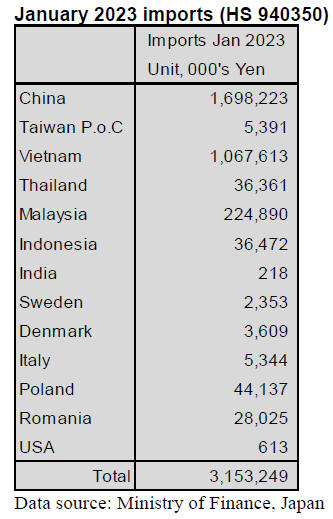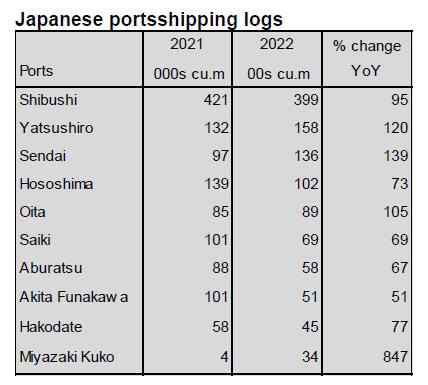Japan
Wood Products Prices
Dollar Exchange Rates of 25th
Mar
2023
Japan Yen 134.0
Reports From Japan
Energy subsidies masked high inflation
The Ministry of Internal Affairs has reported inflation
slowed for the first time in more than a year in February as
energy subsidies masked the stronger underlying upward
trend. Consumer prices excluding fresh food rose 3.1%
from a year ago in February, decelerating by more than
1% from the previous month because of lower household
energy costs.
See:
https://www.japantimes.co.jp/news/2023/03/24/business/inflation-down-february/
Energy bills impact private consumption
Consumer prices in Japan continue to rise and a Mainichi
poll in late March found that of all the price increases
being experienced people are most worried about the
increased cost of electricity.
The skyrocketing cost of generating electricity due to
Russia's invasion of Ukraine and the weaker yen has raised
energy bills. Japan relies heavily on imported coal, gas and
oil.In related news Japan will spend over 2 trillion yen
from the state budget to provide cash handouts to lowincome
families and cut liquefied petroleum gas bills as
part of a fresh inflation-relief package.
See:
https://mainichi.jp/english/articles/20230321/p2a/00m/0na/010000c
Decision on masks up to individuals
In a major shift toward a post-pandemic normal in Japan
the government said it is leaving the decision on masks up
to individuals but with the caveat that businesses can ask
customers or employees to wear masks to prevent
infections.
Towards a circular economy
The Ministry of Economy, Trade and Industry (METI)
will launch an industry-government-academia organisation
to realise a circular economy where resources are used
efficiently through reuse and recycling.
The new body will create a road map to implement a
government plan to expand the resources recycling market
through public and private investments worth more than 2
trillion yen over the next decade.
The organisation will set targets for the use of recycled
materials and plant-derived biomaterials and for waste
reduction. It will also launch a system in 2025 to visualise
how resources are recycled and circulated throughout
supply chains.
See:
https://www.nippon.com/en/news/yjj2023032700875/

Spring outings expected to have a positive
economic
impact
For the first time since the beginning of the pandemic
when large gatherings were discouraged and at times
blocked by local authorities, cherry blossom viewing,
or ‘hanami’, is expected to have a positive economic
impact of US$4.5 billion according to Katsuhiro
Miyamoto, a professor emeritus at Kansai University.
See:
https://www.japantimes.co.jp/news/2023/03/15/business/economy-business/cherry-blossoms-economic-impact/
Once again the Yen the safe haven currency
The yen has, once again, become a preferred foreign
exchange safe haven after banking crises in the US and
Switzerland undermined confidence in the US dollar and
Swiss franc.
This marks a major change for the yen exchange rate
which recently needed intervention from the Bank of
Japan to stop a free fall in the yen/dollar exchange rate.

Wooden buildings assisting de-carbonisation
efforts
Demand for timber buildings is rising against the backdrop
of the need for de-carbonisation.
The Ministry of Land and Housing has reported 36
applications were filed in 2022 for the construction of
wooden buildings with four or more floors above ground.
This compares with 2 10 years ago.
Particularly on the increase are wood-hybrid structures
utilising timber, steel frames and reinforced concrete. Data
from the Forestry Agency show at least 22 such buildings
with six or more stories will be completed by fiscal 2028.
An increasing number of contractors are building more
affordable wood-based hybrids than their pure-timber
counterparts with the hope of attracting tenants that value
their offices’ environmental sustainability. Expectations
are growing that the trend may revitalize forestry and other
industries in rural communities.
With wooden buildings possibly assisting in decarbonisation
efforts, the government is extending support
and offering subsidies to cover construction and timber
procurement costs.
See:
https://www.asahi.com/ajw/articles/14856719
Land prices rising
Land prices in Japan rose in 2022, the second year of
increase. Government data suggests increases have been
observed across the country. In January this year the
Ministry of Land surveyed about 26,000 locations
nationwide and found the average valuation was 1.6%
higher than a year earlier.
See:
https://www.mlit.go.jp/en/totikensangyo/totikensangyo_fr4_000002.html
 
January 2023 wooden office furniture imports
(HS
940330)
Wooden office furniture shipments to Japan from
manufacturers in China accounted for 91% of the value of
all imports of HS 940330 in January. Italy, Vietnam and
Indonesia were the other main sources of imports of
wooden office furniture in January this year.
January shipments from these three sources were down
compared to the value of December 2022 shipments.
Year on year, January 2023 imports were little changed
but compared to the value of December 2022 imports there
was a 7% increase in January 2023.

January 2023 kitchen furniture imports (HS
940340)
Around 75% of the total value of wooden kitchen furniture
(HS940340) imported by Japan in January this year was
from just two sources, the Philippines (42%) and Vietnam
(33%). Other suppliers in the top group were China and
Italy each accounting for around 7% of all wooden kitchen
furniture.
The value of wooden kitchen furniture imports in January
2023 was 6% up on January 2022 and compared to
December 2022 there was a 7% increase.

January 2023 wooden furniture parts imports
(HS 940391)
Japanese furniture makers import wooden furniture
components from a variety of sources and in January 2023
there were 30 source countries indentified in the Ministry
of Finance statistics.

The data shows that in January the top 10 sources
accounted for over 90% of all arrivals of wooden furniture
parts and the main suppliers were in Asia with most of the
balance coming from suppliers in Europe. There were
small shipments from Canada and the US in January.
The top shippers in January were China (51%), Indonesia
(14%, Vietnam (10%) and Malaysia (10%). There was a
22% increase in the value of HS940391 in January
compared to a month earlier and this marked the second
monthly increase. Year on year, January 2023 imports
were 14% up on January 2022.
January 2023 wooden bedroom furniture
imports
(HS 940350)
The value of Japan’s imports of wooden bedroom furinitre
in January 2023 surged almost 18% from a month earlier
breaking a period of 3 months when imports remained flat.
The January 2023 imports were also well up (11%) on the
value of January 2022 imports.
Shipments of HS 940350 from China and Vietnam
dominated January imports accounting for around 95% of
the value of imports for the month. Shipments from both
sources were well up on December values and exporters in
China and Vietnam benefitted from the rise in imports at
the expense of other shippers.

Trade news from the Japan Lumber Reports (JLR)
The Japan Lumber Reports (JLR), a subscription trade
journal published every two weeks in English, is
generously allowing the ITTO Tropical Timber Market
Report to reproduce news on the Japanese market
precisely as it appears in the JLR.
For the JLR report please see:
https://jfpj.jp/japan_lumber_reports/
A new plant in Indonesia
Nankai Plywood Co., Ltd. in Kagawa Prefecture
announced its new plant of PT. Nankai Indonesia, which is
a subsidiary of Nankai Plywood, in Jember Regency of
East Java, Indonesia. The plant will start producing
laminated falcata panels by December, 2023.
The new plant is about 120km far away from Lumajang
plant, which was damaged by an eruption from Mount
Semeru in December, 2021. Then, the company decided to
build a new plant in another area to avoid eruptions.
Lumajang plant is now finished repairs and is back in
operations.
The new plant is conveniently located because there are a
lot of falcata in an afforestation area. Lumajang and
Jember plants will increase the production by 1.5 times.
A list of top ports exporting logs
According to The Trade Statistics of Japan, Shibushi port
in Kagoshima Prefecture exported logs to overseas the
most in 2022. It was 399,844 cbms, 5.2% down from
2021. Since there had been an effect of the woodshock and
the economy had been sluggish in China, many ports in
Japan did not exceed the previous year’s result.
In Tohoku area, there were many inquiries about logs for
plywood from domestic manufacturers because it was
difficult for them to import Russian veneers from Russia
due to the war in Ukraine. Therefore, some ports in
Tohoku area could not export logs very much. On the
other hand, Yatsushiro port in Kumamoto Prefecture had a
good result.
Exporting lumber to overseas is not good even though the
freights are low because the inventory of fences and decks
in the U.S. is overstocking.

South Sea logs and lumber
Bullish inquiries from steelmakers and shipbuilders are
good at the end of the fiscal year in March as usual. In
South Asia, there are not many logs due to the rainy
season. Additionally, there was a localized downpour and
the rainy season will end lately in this year.
There are many orders for South Sea log from South
Korea to Papua New Guinea so the prices of South Sea
logs are high. Markets of South Sea and Chinese lumber
are bearish. The Chinese New Year’s holiday ended in
China and plants are trying to get many orders. Also,
Indonesian manufacturers try to get muchorders by
lowering the prices.
The lumber is popular for building facilities in Japan.
Since distributors’ stock in Japan is not enough, Japanese
distributors buy to fill current needs. The prices in South
Asia are declining but the prices in Japan are level off due
to the weak yen. There is a possibility that the prices of
South Sea lumber for decks would decrease due to less
orders from North America.
To expand Japanese wooden buildings in
overseas
Six Japanese companies started up a council to spread
Japanese wooden buildings in foreign countries on 8th,
March. The six companies are, BX Kaneshin Co., Ltd.,
Tsuzuki Corporation, Polus Group, Meiken Lamwood
Corp., Life Design KABAYA, Inc. and Innosho Forestry
Co., Ltd. The council will spread not only Japanese
wooden buildings but also to develop Japanese business in
overseas. Also, the council will provide information about
parts of wooden buildings and use of the parts.
The president of the council is an associate professor of
The University of Tokyo, Kenji Aoki. The council will
teach a method of constructing a low-rise wooden house.
Additionally, the council will hire people in overseas.
The council starts this project in South Asia such as China,
Vietnam or South Korea. The council plans to operate
precutting plants in foreign countries in the future.
A special feature of floor space
The floor space of per house in 2022 declines 3% from the
previous year. The floor space of per wooden house is 2%
down and 7% down from ten years ago.
Since the cost of land, raw materials, workers and
transportation increased, the price of house became high.
For wooden houses, it is 4.9% down in Tohoku area
and4.4% down in Hokuriku area. The floor space is easily
influenced by a decrease in structural lumber, interior /
exterior finishing materials and other kinds of building
materials. Some housing companies or builders build
luxury and huge houses so it is not for all houses to be
small houses. However, the woodshock and the ironshock
actually influenced many housing companies to build
smaller houses. In the Greater Tokyo Metropolitan area,
there are houses without a garage, a passageway or doors
for storages. In Kyushu area and the suburbs of a city,
demand for a one-story house is popular.
A declining birthrate and aging population, unmarried
people and a tendency to marry later would be the reasons
for a decrease in the floor space.
Some precutting plants have already felt that orders are
getting less and less. Total starts would be about 600,000
units in the future and it is a very hard situation for the
precutting plants to survive in this housing business.
|